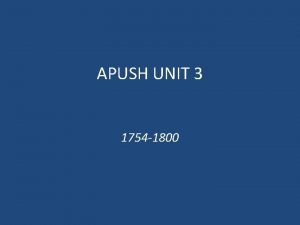Period 4 1800 1848 APUSH Review Key Concept






- Slides: 6

Period 4: 1800 – 1848 APUSH Review: Key Concept 4. 3 Everything You Need To Know About Key Concept 4. 3 To Succeed In APUSH

The New Curriculum �Key Concept 4. 3 “US interest in increasing foreign trade, expanding its national borders, and isolating itself from European conflicts shaped the nation’s foreign policy and spurred government and private initiatives. ” ◦ Page 42 of the Curriculum Framework �Big ideas: ◦ How did the US increase its control of North America? ◦ How did both the North and South oppose the power of the federal government? ◦ How was slavery seen as a divisive issue during this time?

Key Concept 4. 3 I � “Struggling to create an independent global presence, US policymakers sought to dominate the North American continent and to promote its foreign trade. ” – pg 42 of the curriculum framework �After the Louisiana Purchase, the US began to expand trade and contact beyond its borders: ◦ Oregon border: US and Canada eventually settled on the 49 th parallel ◦ Annexing Texas: After Texas declared independence, the US added Texas in 1845 (debates over slavery) ◦ Trading with China: Treaty of Wanghia (1844) improved trading rights for US in China �US sought to dominate North America through military, judicial actions, and diplomatic efforts: ◦ Monroe Doctrine: Warned Europe to stay out of Latin America, in return US would stay out of European affairs ◦ Webster-Ashburton Treaty: helped resolve the Maine/Canada boundary dispute (Aroostook War)

Key Concept 4. 3 II � “Various American groups and individuals initiated, championed, and/or resisted the expansion of territory and/or government powers. ” – pg 42 of the curriculum framework � Debates raised over expansion and incorporation of new territories ◦ Slave vs. non-slave areas (Missouri Compromise – desire to balance the number of slave and free states) � Northern and Southern States resisted the authority of the federal government ◦ Hartford Convention: New England reaction to the War of 1812 and embargoes against Britain (Federalists) ◦ Nullification Crisis: Southern reaction to high tariffs (South Carolina Exposition and Protest) � Those living on the frontier advocated expansion ◦ Warhawks during War of 1812 – Henry Clay ◦ After War of 1812, Natives on the frontier were less of a threat -> pushed further west � Native American conflicts and federal efforts to control Natives ◦ Indian Removal Act – supported by Southerners, pushed Natives west of the Mississippi River �Trail of Tears (1837) – forced removal west of Mississippi ◦ Seminole Wars – series of wars with Natives in Florida

Key Concept 4. 3 III Source: Thomas Jefferson to John � “The American acquisition of lands in the West gave rise to a contest over the extension Randolph, April 22, 1820 of slavery into the western territories as well as a series of attempts at national compromise. ” – pg 43 of the curriculum framework [T]his momentous question, like a firebell in � the night, awakened and filled me with terror. I considered it, at once as the [death] knell of the Union. It is hushed, indeed, for the moment. But this a reprieve only, MO not a = slave, 36º 30’ ◦ 3 parts –is. ME = free, final sentence. A geographical line, coinciding ◦ Thomas Jefferson warned with a marked principle, moral and political, of the effects once conceived and held up to the angry ◦ MO Compromise was later overturned by passions of men, will never be obliterated; > “Bleeding and every new irritation. Kansas” will mark it deeper and deeper. Missouri Compromise had short term success, but eventually broke down �Slavery KS-NB Act - expanded to the Southwest -> increased tensions and debates over national goals, priorities, and strategies

Test Tips �Multiple-Choice Questions: ◦ ◦ and Short Answer States vs. federal government tensions US increasing its power in North America Expansion and Native Americans Missouri Compromise �Essay Questions: ◦ Ways that regions resisted the power of the federal government ◦ Impacts of expansion (politically, socially, economically) on America and various groups (Natives) ◦ Missouri Compromise (as part of other compromises leading to Civil War)










